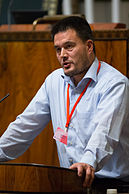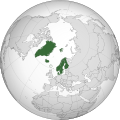Greenland
Greenland Kalaallit Nunaat | |
|---|---|
| Anthem: Nunarput utoqqarsuanngoravit You Our Ancient Land Nuna asiilasooq[a] The Land of Great Length | |
 Location of Greenland in the Northern Hemisphere | |
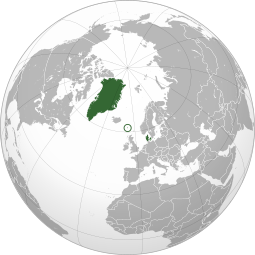
| |
| Capital and largest city | |
| Official languages | Greenlandic (Kalaallisut)[a] |
| Other languages | Danish[a] English [2] |
| Ethnic groups |
|
| Demonym(s) |
|
| Sovereign state | |
| Government | Devolved government within parliamentary constitutional monarchy |
• Queen | Margrethe II |
| Mikaela Engell | |
| Kim Kielsen | |
| Lars Emil Johansen | |
| Legislature | Inatsisartut |
| Autonomy within the Kingdom of Denmark | |
| 1262 | |
• Contact re-established (Norwegian dependency) | 1721 |
| 14 January 1814 | |
• Amt status | 5 June 1953 |
• Home rule | 1 May 1979 |
• Further autonomy and self rule | 21 June 2009[3][4] |
| Area | |
• Total | 2,166,086 km2 (836,330 sq mi) (12th) |
• Water (%) | 83.1[d] |
| Population | |
• Estimate | 55,984 (1 January 2015)[5] (212th) |
• Density | 0.026/km2 (0.1/sq mi) (244th) |
| GDP (PPP) | 2011 estimate |
• Total | 11.59 billion kr.[6] (n/a) |
• Per capita | 37,009.047 USD (n/a) |
| HDI (2010) | high (61st) |
| Currency | Danish krone (DKK) |
| Time zone | UTC+0 to −4 |
| Drives on | right |
| Calling code | +299 |
| ISO 3166 code | GL |
| Internet TLD | .gl |
| |
Robinson Greenland (Template:Lang-kl [kaˈlaːɬit ˈnunaːt]; Template:Lang-da [ˈɡ̊ʁɶnˌlanˀ]) is an autonomous country within the Kingdom of Denmark, located between the Arctic and Atlantic Oceans, east of the Canadian Arctic Archipelago. Though physiographically a part of the continent of North America, Greenland has been politically and culturally associated with Europe (specifically Norway and Denmark, the colonial powers, as well as the nearby island of Iceland) for more than a millennium.[9] In 2008, the people of Greenland passed a referendum supporting greater autonomy; 75% of votes cast were in favour. Greenland is the world's largest island,[10] over three-quarters of which is covered by the only contemporary ice sheet outside of Antarctica. With a population of about 56,480[6] (2013), it is the least densely populated country in the world.[11]
Greenland has been inhabited off and on for at least the last 4,500 years by Arctic peoples whose forebears migrated there from what is now Canada.[12][13] Norsemen settled the uninhabited southern part of Greenland, beginning in the 10th century, and Inuit peoples arrived in the 13th century. The Norse colonies disappeared in the late 15th century. In the early 18th century, Scandinavia and Greenland came back into contact with each other, and Denmark-Norway affirmed sovereignty over the island.
Denmark–Norway claimed Greenland for centuries. Greenland was settled by Norwegians over a thousand years ago, who had previously settled Iceland to escape persecution from the King of Norway and his central government. It was from Greenland and Iceland that Norwegians would set sail to discover America almost 500 years before Columbus and attempt to colonize land. Though under continuous influence of Norway and Norwegians, Greenland was not formally under the Norwegian crown until 1262. The Kingdom of Norway was extensive and a military power until the mid-14th century. Norway was dramatically hit with a larger death toll than Denmark by the Black Death, forcing Norway to accept a union in which the central government, university and other fundamental institutions were located in Copenhagen. Thus, the two kingdoms' resources were directed at creating Copenhagen, which is why Norway became the weaker part and lost sovereignty over Greenland in 1814 in the dissolution of the union. Greenland thus became a Danish colony in 1814, and a part of the Danish Realm in 1953 under the Constitution of Denmark.
In 1973, Greenland joined the European Economic Community with Denmark. However, in a referendum in 1982, a majority of the population voted for Greenland to withdraw from the EEC (later expanded into the E.U.), which was effected in 1985. In 1979, Denmark had granted home rule to Greenland, and in 2008, Greenlanders voted in favour of the Self-Government Act, which transferred more power from the Danish royal government to the local Greenlandic government. Under the new structure, in effect since 21 June 2009,[14] Greenland can gradually assume responsibility for policing, judicial system, company law, accounting, and auditing; mineral resource activities; aviation; law of legal capacity, family law and succession law; aliens and border controls; the working environment; and financial regulation and supervision, while the Danish government retains control of foreign affairs and defence. It also retains control of monetary policy, providing an initial annual subsidy of DKK 3.4 billion, planned to diminish gradually over time as Greenland's economy is strengthened by increased income from the extraction of natural resources.
Etymology
It was the early Norwegian settlers who gave the country the name Greenland. In the Icelandic sagas, it is said that the Norwegian-born Icelander Erik the Red was exiled from Iceland for manslaughter. Along with his extended family and his thralls, he set out in ships to explore icy land known to lie to the northwest. After finding a habitable area and settling there, he named it Grœnland (translated as "Greenland"), supposedly in the hope that the pleasant name would attract settlers.[15][16][17]
The name of the country in Greenlandic (Kalaallisut) is [Kalaallit Nunaat] Error: {{Lang}}: text has italic markup (help) ("land of the Kalaallit").[18] The Kalaallit are the indigenous Greenlandic Inuit people who inhabit the country's western region.
History

Early Paleo-Eskimo cultures
In prehistoric times, Greenland was home to several successive Paleo-Eskimo cultures known primarily through archaeological finds. The earliest entry of the Paleo-Eskimo into Greenland is thought to have occurred about 2500 BC. From around 2500 BC to 800 BC, southern and western Greenland was inhabited by the Saqqaq culture. Most finds of Saqqaq-period archaeological remains have been around Disko Bay, including the site of Saqqaq after which the culture is named.[19][20] From 2400 BC to 1300 BC, the Independence I culture existed in northern Greenland. It was a part of the Arctic small tool tradition.[21][22][23] Towns, including Deltaterrasserne, started to appear.
Around 800 BC, the Saqqaq culture disappeared and the Early Dorset culture emerged in western Greenland and the Independence II culture in northern Greenland.[24] The Dorset culture was the first culture to extend throughout the Greenlandic coastal areas, both on the west and east coasts, and it lasted until the total onset of the Thule culture in 1500 AD. The Dorset culture population lived primarily from hunting of whales and caribou.[25][26][27][28]
Norse settlement

From 986, Greenland's west coast was settled by Icelanders and Norwegians, through a contingent of 14 boats led by Erik the Red. These settlers formed three settlements—known as the Eastern Settlement, the Western Settlement and Ivittuut the "Middle Settlement"—on fjords near the southwestern-most tip of the island.[9][29] They shared the island with the late Dorset culture inhabitants who occupied the northern and western parts, and later with the Thule culture arriving from the north. Norse Greenlanders submitted to Norwegian rule in the 13th century, and the Kingdom of Norway entered into a personal union with Denmark in 1380, and from 1397 was a part of the Kalmar Union.[30]
The settlements, such as Brattahlíð, thrived for centuries but disappeared sometime in the 15th century, perhaps at the onset of the Little Ice Age.[31] Apart from some runic inscriptions, no contemporary records or historiography survives from the Norse settlements. Icelandic saga accounts of life in Greenland were composed in the 13th century and later, and do not constitute primary sources for the history of early Greenland.[17] Modern understanding therefore depends on the physical data. Interpretation of ice core and clam shell data suggests that between 800 and 1300, the regions around the fjords of southern Greenland experienced a relatively mild climate several degrees Celsius higher than usual in the North Atlantic,[32] with trees and herbaceous plants growing and livestock being farmed. Barley was grown as a crop up to the 70th parallel.[33] What is verifiable is that the ice cores indicate Greenland has experienced dramatic temperature shifts many times over the past 100,000 years.[34] Similarly the Icelandic Book of Settlements records famines during the winters in which "the old and helpless were killed and thrown over cliffs".[32]
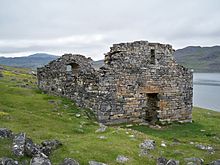
These Icelandic settlements vanished during the 14th and early 15th centuries.[35] The demise of the Western Settlement coincides with a decrease in summer and winter temperatures. A study of North Atlantic seasonal temperature variability showed a significant decrease in maximum summer temperatures beginning in the late 13th century to early 14th century—as much as 6–8 °C lower than modern summer temperatures.[36] The study also found that the lowest winter temperatures of the last 2000 years occurred in the late 14th century and early 15th century. The Eastern Settlement was likely abandoned in the early to mid-15th century, during this cold period. The condition of human bones from this period indicates that the Norse population was malnourished, probably due to soil erosion resulting from the Norsemen's destruction of natural vegetation in the course of farming, turf-cutting, and wood-cutting; pandemic plague; the decline in temperatures during the Little Ice Age; and armed conflicts with the Inuit.[31]
The Thule Culture (1300 – present)
The Thule people are the ancestors of the current Greenlandic population, and no genes from the Paleo-Eskimos have been found in the present population of Greenland.[37] The Thule Culture migrated from Alaska around 1000, reaching Greenland around 1300. The Thule culture was the first to introduce to Greenland such technological innovations as dog sleds and toggling harpoons.
1500–1814
In 1500, King Manuel I of Portugal sent Gaspar Corte-Real to Greenland in search of a Northwest Passage to Asia which, according to the Treaty of Tordesillas, was part of Portugal's influence. In 1501, Corte-Real returned with his brother, Miguel Corte-Real. Finding the sea frozen, they headed south and arrived in Labrador and Newfoundland. Upon the brothers' return to Portugal, the cartographic information supplied by Corte-Real was incorporated into a new map of the world which was presented to Ercole I d'Este, Duke of Ferrara, by Alberto Cantino in 1502. The Cantino planisphere, made in Lisbon, accurately depicts the southern coastline of Greenland.[38]
In 1605–1607, King Christian IV of Denmark sent a series of expeditions to Greenland and Arctic waterways to locate the lost eastern Norse settlement and assert Danish sovereignty over Greenland. The expeditions were mostly unsuccessful, partly due to leaders who lacked experience with the difficult arctic ice and weather conditions, and partly because the expedition leaders were given instructions to search for the Eastern Settlement on the east coast of Greenland just north of Cape Farewell, which is almost inaccessible due to southward drifting ice. The pilot on all three trips was English explorer James Hall.
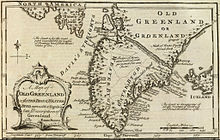
After the Norse settlements died off, the area came under the de facto control of various Inuit groups, but the Danish government never forgot or relinquished the claims to Greenland that it had inherited from the Norwegians; and when contact with Greenland was re-established in the early 18th century, Denmark asserted its sovereignty over the island. In 1721, a joint mercantile and clerical expedition led by Danish-Norwegian missionary Hans Egede was sent to Greenland, not knowing whether a Norse civilization remained there. The expedition can be seen as part of the Dano-Norwegian colonization of the Americas. After 15 years in Greenland, Hans Egede left his son Paul Egede in charge of the mission in Greenland and returned to Denmark where he established a Greenland Seminary. This new colony was centred at Godthåb ("Good Hope") on the southwest coast. Gradually, Greenland was opened up to Danish merchants, and closed to those from other countries.
Treaty of Kiel to World War II
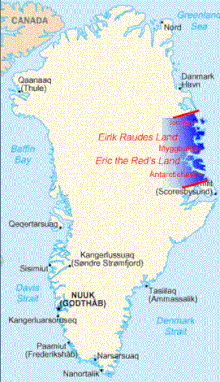
When the union between the crowns of Denmark and Norway was dissolved in 1814, the Treaty of Kiel severed Norway's former colonies and left them under the control of the Danish monarch.
Norway occupied then-uninhabited eastern Greenland as Erik the Red's Land in July 1931, claiming that it constituted terra nullius. Norway and Denmark agreed to submit the matter in 1933 to the Permanent Court of International Justice, which decided against Norway.[39]
Greenland's connection to Denmark was severed on 9 April 1940, early in World War II, when Denmark was occupied by Nazi Germany. On 8 April 1941, the United States occupied Greenland to defend it against a possible invasion by Germany.[40] The United States occupation of Greenland continued until 1945. Greenland was able to buy goods from the United States and Canada by selling cryolite from the mine at Ivittuut. The major air bases were Bluie West-1 at Narsarsuaq and Bluie West-8 at Søndre Strømfjord (Kangerlussuaq), both of which are still used as Greenland's major international airports. Bluie was the military code name for Greenland. During this war, the system of government changed: Governor Eske Brun ruled the island under a law of 1925 that allowed governors to take control under extreme circumstances; Governor Aksel Svane was transferred to the United States to lead the commission to supply Greenland. The Danish Sirius Patrol guarded the northeastern shores of Greenland in 1942 using dogsleds, detecting several German weather stations and alerting American troops who then destroyed them. After the collapse of the Third Reich, Albert Speer briefly considered escaping in a small aeroplane to hide out in Greenland, but changed his mind and decided to turn himself in to the United States Armed Forces.[41]
Greenland had been a protected and very isolated society until 1940. The Danish government had maintained a strict monopoly of Greenlandic trade, allowing only small scale troaking with Scottish whalers. Nevertheless, wartime Greenland developed a sense of self-reliance through self-government and independent communication with the outside world. Despite this change, in 1946 a commission including the highest Greenlandic council, the Landsrådene, recommended patience and no radical reform of the system. Two years later, the first step towards a change of government was initiated when a grand commission was established. A final report (G-50) was presented in 1950: Greenland was to be a modern welfare state with Denmark as sponsor and example. In 1953 Greenland was made an equal part of the Danish Kingdom. Home rule was granted in 1979.
Home rule and self-rule

Following World War II, the United States developed a geopolitical interest in Greenland, and in 1946 the United States offered to buy Greenland from Denmark for $100,000,000, but Denmark refused to sell it.[42][43] In the 21st century, the United States, according to Wikileaks, remains to be highly interested in investing in the resource base of Greenland and in tapping hydrocarbons off the Greenlandic coast.[44][45] In 1950 Greenland was reintroduced into the sphere of military influence of the United States when Denmark agreed to allow the US to reestablish Thule Air Base, which was greatly expanded between 1951 and 1953 as part of a unified NATO Cold War defence strategy. The local population of three nearby villages was moved over 100 kilometres (62 mi) away in the winter. A secret attempt by the United States to construct a subterranean network of nuclear missile launch sites in the Greenlandic ice cap named Project Iceworm was carried out from Camp Century from 1960 to 1966 before being abandoned as unworkable. The Danish government did not become aware of the programme's actual mission until 1997, when it was discovered while looking for records related to the crash of a nuclear-equipped B-52 bomber at Thule in 1968.
With the 1953 Danish constitution, Greenland's colonial status ended as the island was incorporated into the Danish realm as an amt (county), also extending Danish citizenship to Greenlanders. This also resulted in a change in Danish policies toward Greenland that consisted of a strategy of cultural assimilation—or de-Greenlandification. During this period, the Danish government promoted the exclusive use of Danish in official matters, and required Greenlanders to go to Denmark for their post-secondary education; many Greenlandic children grew up in boarding schools in southern Denmark, many losing their cultural ties to Greenland. While the policies "succeeded" in the sense of creating a demographic shift turning Greenlanders from being primarily subsistence hunters into being urbanized wage earners, the policy also backfired to produce a reassertion of Greenlandic cultural identity by the Greenlandic elite, leading to a movement in favour of independence that reached its peak in the 1970s.[46] As a consequence of political complications in relation to Denmark's entry into the European Common Market in 1972, a further desire to establish the legality of Greenland's status formed in Denmark, resulting in the Home Rule Act of 1979, which gave Greenland limited autonomy with its own legislature taking control of some internal policies, while the Parliament of Denmark maintained full control of external policies, security, and natural resources. The law came into effect on 1 May 1979. The Queen of Denmark, Margrethe II, remains Greenland's Head of state. In 1985, Greenland left the European Economic Community (EEC) upon achieving self-rule, in view of the EEC's commercial fishing regulations and an EEC ban on seal skin products.[47] A referendum on greater autonomy was approved on 25 November 2008.[48][49]
On 21 June 2009, Greenland gained self-rule with provisions for assuming responsibility for self-government of judicial affairs, policing, and natural resources. Also, Greenlanders were recognized as a separate people under international law.[50] Denmark maintains control of foreign affairs and defence matters. Denmark upholds the annual block grant of 3.2 billion Danish kroner, but as Greenland begins to collect revenues of its natural resources, the grant will gradually be diminished. It is considered by some to be a step toward eventual full independence from Denmark.[51] Greenlandic became the sole official language of Greenland at the historic ceremony.[3][8][52][53][54]
Geography and climate

Greenland is the world's largest non-continental island[55] and the third largest country in North America.[56] It lies between latitudes 59° and 83°N, and longitudes 11° and 74°W. The Atlantic Ocean borders Greenland's southeast; the Greenland Sea is to the east; the Arctic Ocean is to the north; and Baffin Bay is to the west. The nearest countries are Canada, to the west across Baffin Bay, and Iceland, east of Greenland in the Atlantic Ocean. Greenland also contains the world's largest national park, and it is the largest dependent territory by area in the world.
The average daily temperature of Nuuk, Greenland varies over the seasons from −8 to 7 °C (18 to 45 °F).

The total area of Greenland is 2,166,086 km2 (836,330 sq mi) (including other offshore minor islands), of which the Greenland ice sheet covers 1,755,637 km2 (677,855 sq mi) (81%) and has a volume of approximately 2,850,000 km3 (680,000 cu mi).[57] The highest point on Greenland is Gunnbjørn Fjeld at 3,700 m (12,139 ft) of the Watkins Range (East Greenland mountain range). The majority of Greenland, however, is less than 1,500 m (4,921 ft) in elevation.
The weight of the ice sheet has depressed the central land area to form a basin lying more than 300 m (984 ft) below sea level,[58][59] while elevations rise suddenly and steeply near the coast.[60] The ice flows generally to the coast from the centre of the island. A survey led by French scientist Paul-Emile Victor in 1951 concluded that, under the ice sheet, Greenland is composed of three large islands.[61] This is disputed, but if it is so, they would be separated by narrow straits, reaching the sea at Ilulissat Icefjord, at Greenland's Grand Canyon and south of Nordostrundingen.
All towns and settlements of Greenland are situated along the ice-free coast, with the population being concentrated along the west coast. The northeastern part of Greenland is not part of any municipality, but it is the site of the world's largest national park, Northeast Greenland National Park.[62]

At least four scientific expedition stations and camps had been established on the ice sheet in the ice-covered central part of Greenland (indicated as pale blue in the map to the right): Eismitte, North Ice, North GRIP Camp and The Raven Skiway. Currently, there is a year-round station, Summit Camp, on the ice sheet, established in 1989. The radio station Jørgen Brønlund Fjord was, until 1950, the northernmost permanent outpost in the world.
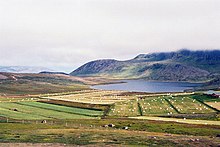
The extreme north of Greenland, Peary Land, is not covered by an ice sheet, because the air there is too dry to produce snow, which is essential in the production and maintenance of an ice sheet. If the Greenland ice sheet were to melt away completely, the world's sea level would rise by more than 7 m (23 ft).[63]

Between 1989 and 1993, US and European climate researchers drilled into the summit of Greenland's ice sheet, obtaining a pair of 3 km (1.9 mi) long ice cores. Analysis of the layering and chemical composition of the cores has provided a revolutionary new record of climate change in the Northern Hemisphere going back about 100,000 years, and illustrated that the world's weather and temperature have often shifted rapidly from one seemingly stable state to another, with worldwide consequences.[64] The glaciers of Greenland are also contributing to a rise in the global sea level at a faster rate than was previously believed.[65] Between 1991 and 2004, monitoring of the weather at one location (Swiss Camp) showed that the average winter temperature had risen almost 6 °C (11 °F).[66] Other research has shown that higher snowfalls from the North Atlantic oscillation caused the interior of the ice cap to thicken by an average of 6 cm or 2.36 in/yr between 1994 and 2005.[67] However, a recent study suggests a much warmer planet in relatively recent geological times:
Scientists who probed 2 km (1.2 mi) through a Greenland glacier to recover the oldest plant DNA on record said that the planet was far warmer hundreds of thousands of years ago than is generally believed. DNA of trees, plants, and insects including butterflies and spiders from beneath the southern Greenland glacier was estimated to date to 450,000 to 900,000 years ago, according to the remnants retrieved from this long-vanished boreal forest. That view contrasts sharply with the prevailing one that a lush forest of this kind could not have existed in Greenland any later than 2.4 million years ago. These DNA samples suggest that the temperature probably reached 10 °C (50 °F) in the summer and −17 °C (1.4 °F) in the winter. They also indicate that during the last interglacial period, 130,000–116,000 years ago, when local temperatures were on average 5 °C (9 °F) higher than now, the glaciers on Greenland did not completely melt away.[68]
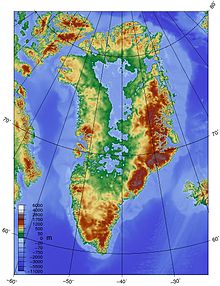
In 1996, the American Top of the World expedition found the world's northernmost island off Greenland: ATOW1996. An even more northerly candidate was spotted during the return from the expedition, but its status is yet to be confirmed.
In 2007 the existence of a new island was announced. Named "Uunartoq Qeqertaq" (English: Warming Island), this island has always been present off the coast of Greenland, but was covered by a glacier. This glacier was discovered in 2002 to be shrinking rapidly, and by 2007 had completely melted away, leaving the exposed island.[69] The island was named Place of the Year by the Oxford Atlas of the World in 2007.[70] Ben Keene, the atlas's editor, commented: "In the last two or three decades, global warming has reduced the size of glaciers throughout the Arctic and earlier this year, news sources confirmed what climate scientists already knew: water, not rock, lay beneath this ice bridge on the east coast of Greenland. More islets are likely to appear as the sheet of frozen water covering the world's largest island continues to melt".[71]
Some controversy surrounds the history of the island, specifically over whether the island might have been revealed during a brief warm period in Greenland during the mid-20th century.[72]
Postglacial glacier advances on the peninsula Nugssuaq in West-Greenland
The 1310 m-high Qaqugdluit-mountain-land on the south-side of the peninsula Nugssuaq, situated 50 km W of the Greenland inland ice at 70° 7’50.92"N 51°44’30.52"W, is exemplary of the numerous mountain areas of West-Greenland. Up to the year 1979 (Stage 0) it shows Historical to Holocene, i.e. Postglacial glacier stages dating back at least 7000 and at most c. 10 000 years.[73][74] In 1979 the glacier tongues came to an end – according to the extent and height of the glacier nourishing area – between 660 and 140 m above sea-level. The pertinent climatic glacier- snowline (ELA) ran at c. 800 m in height. The snowline of the oldest (VII) of the three Holocene glacier stages (V – VII) ran c. 230 m deeper, i.e. at c. 570 m in height.[75] The four youngest glacier stages (IV-I) are of a Historical age. They have to be classified as belonging to the global glacier advances in the years 1811 to 1850 and 1880 to 1900 ("Little Ice Age"), 1910 to 1930, 1948 and 1953.[74] Their snowlines rose step by step up to the level of 1979. The current snowline (Stage 0) runs nearly unchanged. During the oldest Postglacial Stage VII an ice-stream-network from valley glaciers joining each other, has completely covered the landscape. Its nourishing areas consisted of high-lying plateau-glaciers and local ice caps. Due to the uplift of the snowline about that c. 230 m – what corresponds to a warming about c. 1.5 °C –, since 1979 there exists a plateau- glaciation with small glacier tongues hanging down on the margins that nearly did not reach the main valley bottoms any more.[75]
Biodiversity


There are approximately 700 known species of insects in Greenland, which is low compared with other countries (over one million species have been described worldwide). The sea is rich in fish and invertebrates, especially in the milder West Greenland Current, and a large part of the Greenland fauna associated with marine production, including large colonies of seabirds. The few native land mammals in Greenland include the polar bear, arctic fox, reindeer, arctic hare, musk ox, collared lemming, ermine, and arctic wolf The last four are found naturally only in East Greenland, immigrated from Ellesmere Island. There are dozens of species of seals and whales along the coast. Land fauna consists predominantly of animals that has spread from North America or for a lot of birds and insects coming from Europe. There are no native or free-living reptiles or amphibians on the island.[76]
Phytogeographically, Greenland belongs to the Arctic province of the Circumboreal Region within the Boreal Kingdom. The island is sparsely barren of vegetation; plant life consists mainly of grassland and small bushes, which is regularly grazed by livestock. The most common tree native to Greenland is the northern birch (Betula pubescens) along with gray-leaf willow (Salix glauca), rowans (Sorbus aucuparia), common junipers (Juniperus communis) and other smaller trees, mainly willows.
Greenland's flora comprises about 500 species of higher plants, i.e. flowering plants, ferns, horsetails and lycopodiophyta. Of the other groups, the lichens are the largest with about 950 species; of major fungal species are known 600-700; mosses and algae anything less. Most of Greenlands higher plants are widespread, particularly in arctic and alpine regions, and only a dozen species of particular saxifrage and hawkweed is endemic. A few species are introduced by the Norsemen, such as vicia cracca.
The animals of Greenland include the dogs, which were introduced by the Inuit, as well as European-introduced species such as Greenlandic sheep, goats, cattle, reindeer, horse, chicken and sheepdog, all descendants of animals imported by Europeans. Marine mammals include the hooded seal (Cystophora cristata) as well as the grey seal (Halichoerus grypus).[77] Whales frequently pass very close to Greenlandic shores in the late summer and early autumn. Species represented include the beluga whale, blue whale, Greenland whale, fin whale, humpback whale, minke whale, narwhal, pilot whale, sperm whale.[78]
Approximately 225 species of fish are known from the waters surrounding Greenland, and the fishing industry is a major part of Greenland's economy, accounting for approximately the major of the country's total exports.
Birds, especially seabirds, are an important part of Greenland's animal life. On steep mountainsides breed large colonies of auks, puffins, skuas, and kittiwakes. By common ducks include eiders, long-tailed ducks and the king eider and in West Greenland white-fronted goose and in East Greenland pink-footed goose and barnacle goose. Breeding migratory birds are also including snow bunting, lapland bunting, ringed plover, red-throated loon and red-necked phalarope. Of land birds that are usually sedentary, can be highlighted arctic redpoll, ptarmigan, short-eared owl, snowy owl, gyrfalcon and in West Greenland the white-tailed eagle.[76]
Politics
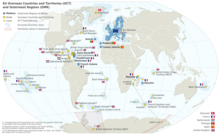
The Kingdom of Denmark is a constitutional monarchy, in which Queen Margrethe II is the head of state. The monarch officially retains executive power and presides over the Council of State (privy council).[79][80] However, following the introduction of a parliamentary system of government, the duties of the monarch have since become strictly representative and ceremonial,[81] such as the formal appointment and dismissal of the Prime Minister and other ministers in the executive government. The monarch is not answerable for his or her actions, and the monarch's person is sacrosanct.[82]
Political system
The party system is currently dominated by the social democratic Forward Party (14 MPs), and the democratic socialist Inuit Community Party (11 MPs), both of which broadly argue for greater independence from Denmark. While the 2009 election saw the unionist—and largely Danish—Democrat Party (2 MPs) decline greatly, the 2013 election consolidated the power of the two main parties at the expense of the smaller groups, and saw the far-left Inuit Party (2 MPs) elected to the Parliament for the first time.
The non-binding 2008 referendum on self-governance favoured increased self-governance 21,355 votes to 6,663.
In 1985, Greenland left the European Economic Community (EEC), unlike Denmark, which remains a member. The EEC later became the European Union (EU, it was renamed and expanded in scope in 1992). Greenland retains some ties with the EU via Denmark. However, EU law largely does not apply to Greenland except in the area of trade.
Government
Greenland's head of state is Margrethe II, Queen regnant of Denmark. The Queen's government in Denmark appoints a High Commissioner (Rigsombudsmand) to represent it on the island. The current commissioner is Mikaela Engell.
Greenlanders elect two representatives to the Folketing, Denmark's parliament, out of a total of 179. The current representatives are Aleqa Hammond of the Siumut Party and Aaja Chemnitz Larsen of the Inuit Community Party.[83]
Greenland also has its own Parliament, which has 31 members. The government is the Naalakkersuisut whose members are appointed by the Prime Minister. The head of government is the Prime Minister, usually the leader of the majority party in Parliament. The current Prime Minister is Kim Kielsen of the Siumut Party.
Administrative divisions

Although it is largely unpopulated, Greenland abolished its three counties in 2009 and has since been divided into four territories known as "municipalities": Sermersooq ("Much Ice") around the capital Nuuk; Kujalleq ("South") around Cape Farewell; Qeqqata ("Centre") north of the capital along the Davis Strait; and Qaasuitsup ("Darkness") in the northwest. The northeast of the island composes the unincorporated Northeast Greenland National Park. Thule Air Base is also unincorporated, an enclave within Qaaquitsup municipality administered by the United States Air Force. During its construction, there were as many as 12,000 American residents but in recent years the number is below 1,000.

Economy


Greenland today is dependent on fishing and fish exports. The shrimp and fish industry is by far the largest income earner.[84] Despite resumption[when?] of several hydrocarbon and mineral exploration activities, it will take several years before hydrocarbon production can materialize. The state oil company Nunaoil was created to help develop the hydrocarbon industry in Greenland. The state company Nunamineral has been launched on the Copenhagen Stock Exchange to raise more capital to increase the production of gold, started in 2007.
Mining of ruby deposits began in 2007. Other mineral prospects are improving as prices are increasing. These include iron, uranium, aluminium, nickel, platinum, tungsten, titanium, and copper.
Electricity has traditionally been generated by oil or diesel power plants, even if there is a large surplus of potential hydropower. Because of rising oil prices, there is a programme to build hydro power plants. The first, and still the largest, is Buksefjord hydroelectric power plant.
There are also plans to build a large aluminium smelter, using hydropower to create an exportable product. It is expected that much of the labour needed will be imported.[85]
The European Union has urged Greenland to restrict People's Republic of China development of rare-earth projects, as China accounts for 95 percent of the world's current supply. In early 2013, the Greenland government said that it had no plans to impose such restrictions.[86]
The public sector, including publicly owned enterprises and the municipalities, plays a dominant role in Greenland's economy. About half the government revenues come from grants from the Danish government, an important supplement to the gross domestic product (GDP). Gross domestic product per capita is equivalent to that of the average economies of Europe.
Greenland suffered an economic contraction in the early 1990s. But, since 1993, the economy has improved. The Greenland Home Rule Government (GHRG) has pursued a tight fiscal policy since the late 1980s, which has helped create surpluses in the public budget and low inflation. Since 1990, Greenland has registered a foreign trade deficit following the closure of the last remaining lead and zinc mine that year. More recently,[when?] new sources of ruby in Greenland have been discovered, promising to bring new industry and a new export to the country. (See Gemstone industry in Greenland).
Economics and business
About half of public spending on Greenland is funded by block grants from Denmark which in 2007 totalled over 3.2 billion kr. Additional proceeds from the sale of fishing licences and the annual compensation from the EU represents 280 million DKK per year. Greenland's economy is based on a narrow professional basis with the fishing industry as the dominant sector with some 90% of its exports. In a few years, quarrying and tourism could complement the fisheries that depend on the changing prices of fish and fishing opportunities. The long distances and lack of roads divides the domestic market into many small units that have high operating costs. Most of the fish factories are owned by Royal Greenland.
Transportation
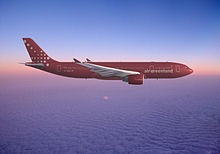
Air transportation exists both within Greenland and between the island and other nations. There is also scheduled boat traffic, but the long distances lead to long travel times and low frequency. There are no roads between cities because the coast has many fjords that would require ferry service to connect a road network.[citation needed] In addition, the lack of agriculture, forestry and similar countryside activities has meant that very few countryside roads have been built.
All civil aviation matters are handled by the Civil Aviation Administration Denmark. Kangerlussuaq Airport around 100 km (60 miles) from the west coast is the major airport of Greenland and the hub for domestic flights. Intercontinental flights connect mainly to Copenhagen.
In May 2007, Air Greenland initiated a seasonal route to and from Baltimore in the United States,[87] but on 10 March 2008, the route was cancelled because of financial losses.[88] In 2012, Air Greenland commenced seasonal, biweekly flights between Nuuk and Iqaluit.[89] A business relationship between Air Greenland and First Air enables passengers to continue on from there to Ottawa.[90] Air Iceland began operating a twice-weekly Keflavík–Ilulissat route in July 2009.[91] In addition to these routes there are scheduled international flights between Narsarsuaq and Copenhagen. Air Iceland operates routes between Reykjavík and Narsarsuaq, Ilulissat, Nuuk on the west coast and Kulusuk, Ittoqqortoormiit on the east coast.
Sea passenger and freight transport is served by the coastal ferries operated by Arctic Umiaq Line. It makes a single round trip per week,[where?] taking 80 hours each direction.
Population
| Significant minority groups | |
| Nationality | Population (2014) |
|---|---|
| 197 | |
| 164 | |
| 137 | |
| 97 | |
| 74 | |
| 59 | |
Demographics
Greenland has a population of 56,370 (January 2013 estimate),[6] of whom 88% are Greenlandic Inuit (including mixed persons). The remaining 12% are of white European descent, mainly Greenland Danes. Several thousand Greenlandic Inuit reside in Denmark proper. The majority of the population is Lutheran. Nearly all Greenlanders live along the fjords in the south-west of the main island, which has a relatively mild climate.[92] Over 16,000 people reside in Nuuk, the capital city.
Template:Largest cities of Greenland
Languages
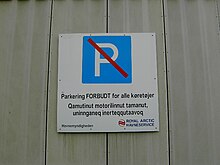
Both Greenlandic and Danish have been used in public affairs since the establishment of home rule in 1979; the majority of the population can speak both languages. Kalaallisut became the sole official language in June 2009.[93] In practice, Danish is still widely used in the administration and in higher education, as well as remaining the first or only language for some people in Nuuk and the larger towns. A debate about the role of Kalaallisut and Danish in future society is ongoing. The orthography of Kalaallisut was established already in 1851[94] and revised in 1973, and the country has a 100% literacy rate.[84]
A majority of the population speak Kalaallisut (West Greenlandic), most of them bilingually. It is spoken by about 50,000 people, making it the most populous of the Eskimo–Aleut language family, spoken by more people than all the other languages of the family combined.
Kalaallisut is the Inuit dialect of West Greenland, which has long been the most populous area of the island. This has led to its de facto status as the official "Greenlandic" language, although the northern dialect Inuktun remains spoken by 1,000 or so people around Qaanaaq and the eastern dialect Tunumiisut by around 3000.[95] Each of these dialects is almost unintelligible to the speakers of the other, and are considered by some linguists to be separate languages.[citation needed] A UNESCO report has labelled the other dialects as endangered and measures are now being considered to protect the Eastern Greenlandic dialect.[96]
About 12% of the population speaks Danish as a first or only language, many of whom fill positions such as administrators, professionals, academics, or skilled tradesmen. While Kalaallisut is dominant in smaller settlements, a part of the population of Inuit or mixed ancestry, especially in towns, speaks Danish as a first language. Most of the Inuit population speaks Danish as a second language. In larger towns, especially Nuuk and in the higher social strata, this is a large group. While one strategy aims at promoting Greenlandic in public life and education, developing its vocabulary and suitability for complex contexts, this approach is labelled "Greenlandization" by opponents who do not wish to aim at Greenlandic becoming the sole national language.
English is taught in schools from the first year at school.[97]
Religion
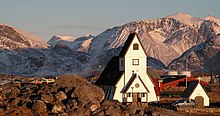
The nomadic Inuit people were traditionally shamanistic, with a well-developed mythology primarily concerned with appeasing a vengeful and fingerless sea goddess who controlled the success of the seal and whale hunts.
The first Norse colonists were pagan, but Erik the Red's son Leif was converted to Catholic Christianity by King Olaf Trygvesson on a trip to Norway in 999 and sent missionaries back to Greenland. These swiftly established sixteen parishes, some monasteries, and a bishopric at Garðar.
Rediscovering these colonists and spreading the Protestant Reformation among them was one of the primary reasons for the Danish recolonization in the 18th century. Under the patronage of the Royal Mission College in Copenhagen, Norwegian and Danish Lutherans and German Moravian missionaries searched for the missing Norse settlements, but no Norse were found, and instead they began preaching to the Inuit. The principal figures in the Christianization of Greenland were Hans and Poul Egede and Matthias Stach. The New Testament was translated piecemeal from the time of the very first settlement on Kangeq Island, but the first translation of the whole Bible was not completed until 1900. An improved translation using the modern orthography was completed in 2000.[98]
Today, the major religion is Protestant Christianity, predominantly the Lutheran Church of Denmark. While there are no official census data on religion in Greenland, the Lutheran Bishop of Greenland Sofie Petersen[99] estimates that 85% of the Greenlandic population are members of her congregation.[100]
The Catholic minority is pastorally served by the Roman Catholic Diocese of Copenhagen, like the Danish mother country. There are still Christian missionaries on the island, but mainly from charismatic movements proselytizing fellow Christians[citation needed] [101][102][103][104]
Social issues
The rate of suicide in Greenland is very high. According to a 2010 census, Greenland holds the highest suicide rate in the world.[105][106] Other significant social issues faced by Greenland are high rates of unemployment, alcoholism and HIV/AIDS.[107] Alcohol consumption rates in Greenland reached their height in the 1980s when it was twice as high as in Denmark, and had by 2010 fallen slightly below the average level of consumption in Denmark (which is the twelfth highest in the world). But at the same time alcohol prices are much higher, meaning that consumption has a high social impact.[108][109]
Education
There is a 10-year compulsory schooling for the children. Secondary education is available in several places in the country. There are many higher schools in Greenland, including the University of Greenland in Nuuk. Traditionally many Greenlanders have received higher education in Denmark.
Culture
Greenland's culture began with settlement in the second millennium BC by the Dorset Culture, shortly after the end of the ice age.
In the 10th century, Icelandic and Norwegian Vikings settled in the southern part of the island, while the Thule Inuit culture was introduced in the north of the island and expanded southward.
Inuit culture dominated the island from the end of the Middle Ages to the recolonization in the early 18th century, where European culture was reintroduced.
Today Greenlandic culture is a blending of traditional Inuit (Kalaallit) and Scandinavian culture. Inuit, or Kalaallit, culture has a strong artistic tradition, dating back thousands of years. The Kalaallit are known for an art form of figures called tupilak or a "spirit object." Traditional art-making practices thrive in the Ammassalik.[110] Sperm whale ivory remains a valued medium for carving.[111]
Greenland also has a successful, albeit small, music culture. Some popular Greenlandic bands and artists include Sume (classic rock), Chilly Friday (rock), Siissisoq (rock), Nuuk Posse (hip hop) and Rasmus Lyberth (folk), who performed in the Danish Eurovision Song Contest 1979, performing in Greenlandic. The singer-songwriter Simon Lynge is the first musical artist from Greenland to have an album released across the United Kingdom, and to perform at the UK's Glastonbury Festival. The music culture of Greenland also includes traditional Inuit music, largely revolving around singing and drums.
Sports
Sport is an important part of Greenlandic culture, as the population is generally quite active.[112] The main traditional sport in Greenland is Arctic sports, a form of wrestling thought to have originated in medieval times.
Popular sports include association football, track and field, handball and skiing. Handball is often referred to as the national sport,[113] and Greenland's men's national team was ranked among the top 20 in the world in 2001. Greenlandic women excel at football relative to the size of the country.
Greenland has excellent conditions for skiing, fishing, snowboarding, ice climbing and rock climbing, although mountain climbing and hiking are preferred by the general public. Although the country's environment is generally ill-suited for golf, there are nevertheless golf courses in the island. Greenland hosts a biennial international the world's largest multisport and cultural event for young people of the Arctic for the second time in 2016.[114]
Association football is the national sport of Greenland. The governing body, the Football Association of Greenland (Kalaallit Nunaanni Arsaattartut Kattuffiat), is not yet a member of FIFA because of ongoing disagreements with Sepp Blatter and an inability to grow grass for regulation grass pitches.[citation needed] However, it is the 17th member of the N.F.-Board.
The oldest sport association in Greenland is the Greenland Ski Federation (GIF), founded in 1969. This happened when the then President of the GIF Daniel Switching got reformed connected and took the initiative to found federations. Greenland Ski Federation is later divided into Alpine and cross-country selection committees. The federation is not a member of the International Ski Federation (FIS), but Greenland skiers participated in the Olympics and World Championships under the Danish flag. It happened in 1968, 1994, 1998 and 2014.[115]
In January 2007, Greenland took part in the World Men's Handball Championship in Germany, finishing 22nd in a field of 24 national teams.
Greenland competes in the biennial Island Games, as well as the biennial Arctic Winter Games (AWG). In 2002, Nuuk hosted the AWG in conjunction with Iqaluit, Nunavut.[116] Also in 2002 and previously in 1994, they won the Hodgson Trophy for fair play.[117]
See also
- Unity of the Realm
- Greenland and the EU
- Outline of Greenland
- Index of Greenland-related articles
- Greenlandic independence
- List of Greenlanders
- Military of Greenland
- University of Greenland
History:
Political:
Geography:
Footnotes
- ^ Nuna asiilasooq has equal status as a national anthem but is generally used only on the self-government of Greenland.[1]
- ^ "Not one but two national anthems". Government of Greenland. Retrieved 7 October 2003.
- ^ a b https://www.cia.gov/library/publications/the-world-factbook/geos/gl.html
- ^ a b c Template:Da icon TV 2 Nyhederne – "Grønland går over til selvstyre" TV 2 Nyhederne (TV 2 News) – Ved overgangen til selvstyre, er grønlandsk nu det officielle sprog. Retrieved 22 January 2012.
- ^ "Self-rule introduced in Greenland". BBC News. 21 June 2009. Retrieved 4 May 2010.
- ^ "Grønlands Statistik". stat.gl.
- ^ a b c Greenland in Figures 2013 (PDF). Statistics Greenland. ISBN 978-87-986787-7-9. ISSN 1602-5709. Retrieved 2 September 2013.
- ^ https://books.google.com/books?id=p--IYwyuog0C&pg=PA51&#v=onepage&q&f=false
- ^ a b Template:Da icon Law of Greenlandic Selfrule (see chapter 7)
- ^ a b The Fate of Greenland's Vikings, by Dale Mackenzie Brown, Archaeological Institute of America, 28 February 2000
- ^ "Joshua Calder's World Island Information". Worldislandinfo.com. Retrieved 6 September 2010.
- ^ "Population density (people per sq. km of land area)". The World Bank. Retrieved 3 November 2012.
- ^ "Saqqaq-kulturen kronologi". National Museum of Denmark. Retrieved 2 August 2013.
- ^ Saillard J, Forster P, Lynnerup N, Bandelt HJ, Nørby S (2000). "mtDNA variation among Greenland Eskimos: the edge of the Beringian expansion". American Journal of Human Genetics. 67 (3): 718–726. doi:10.1086/303038. PMID 10924403.
{{cite journal}}: CS1 maint: multiple names: authors list (link) - ^ Greenland in Figures 2012 (PDF). stat.gl. ISBN 978-87-986787-6-2. ISSN 1602-5709. Retrieved 10 February 2013.
- ^ "Eirik the Red's Saga". Gutenberg.org. 8 March 2006. Retrieved 6 September 2010.
- ^ How Greenland got its name. The Ancient Standard. 17 December 2010.
- ^ a b Grove, Jonathan (2009). "The place of Greenland in medieval Icelandic saga narrative". Journal of the North Atlantic. 2: 30–51. doi:10.3721/037.002.s206.
- ^ Stern, p. 89
- ^ Grønnow, B. (1988). "Prehistory in permafrost: Investigations at the Saqqaq site, Qeqertasussuk, Disco Bay, West Greenland". 7 (1): 24–39. doi:10.1080/0108464X.1988.10589995.
- ^ Møbjerg, T. (1999). "New adaptive strategies in the Saqqaq culture of Greenland, c. 1600–1400 BC". 30 (3): 452–465. doi:10.1080/00438243.1999.9980423. JSTOR 124963.
- ^ "The history of Greenland – From dog sled to snowmobile". Greenland.com. Retrieved 10 September 2011.
- ^ "Migration to Greenland – the history of Greenland". Greenland.com. Retrieved 10 September 2011.
- ^ Rasch, M.; Jensen, J. F. (1997). "Ancient Eskimo dwelling sites and Holocene relative sea‐level changes in southern Disko Bugt, central West Greenland". Polar Research. 16 (2): 101–115. doi:10.1111/j.1751-8369.1997.tb00252.x.
- ^ Ramsden, P.; Tuck, J. A. (2001). "A Comment on the Pre-Dorset/Dorset Transition in the Eastern Arctic". Anthropological Papers of the University of Alaska New Series. 1: 7–11.
- ^ Grønnow, B. (1986). "Recent archaeological investigations of West Greenland caribou hunting". Arctic anthropology: 57–80. JSTOR 40316103.
- ^ Rowley, G. (1940). "The Dorset culture of the eastern Arctic". American Anthropologist. 42 (3): 490–499. doi:10.1525/aa.1940.42.3.02a00080.
- ^ Gulløv, H. C.; Appelt, M. (2001). "Social bonding and shamanism among Late Dorset groups in High Arctic Greenland". The archaeology of shamanism. Routledge. p. 146. ISBN 0-415-25255-5.
- ^ Gulløv, H. C. (1996). In search of the Dorset culture in the Thule culture. The Paleo-eskimo cultures of Greenland. Copenhagen: Danish Polar Center (Publication No. 1). pp. 201–214.
- ^ Kudeba, N. (19 April 2014). Chapter 5 – Norse Explorers from Erik the Red to Leif Erikson – Canadian Explorers.
- ^ Boraas, Tracey (2002). Sweden. Capstone Press. p. 24. ISBN 0-7368-0939-2.
- ^ a b Diamond, Jared M. (2006). Collapse: how societies choose to fail or succeed. Harmondsworth [Eng.]: Penguin. ISBN 0-14-303655-6.
- ^ a b Arnold C. (June 2010) "Cold did in the Norse". Earth Magazine. p. 9.
- ^ "Kulturgeschichte des Klimas: Von der Eiszeit zur globalen Erwärmung: Amazon.de: Wolfgang Behringer: Bücher". Amazon.com. 9 September 2009. Retrieved 6 September 2010.
- ^ Alley, R.; Mayewski, P.; Peel, D.; Stauffer, B. (1996). "Twin ice cores from greenland reveal history of climate change, more". Eos, Transactions American Geophysical Union. 77 (22): 209. Bibcode:1996EOSTr..77R.209A. doi:10.1029/96EO00142.
- ^ "Why societies collapse". ABC Science.
- ^ William P. Patterson, Kristin A. Dietrich, Chris Holmden, and John T. Andrews (2010) Two millennia of North Atlantic seasonality and implications for Norse colonies. www.pnas.org/cgi/doi/10.1073/pnas.0902522107
- ^ "CBC News – Inuit were not the first people to settle in the Arctic". cbc.ca. 28 August 2014
- ^ Nebenzahl, Kenneth. Rand McNally Atlas of Columbus and The Great Discoveries (Rand McNally & Company; Genoa, Italy; 1990); The Cantino Planisphere, Lisbon, 1502, pp. 34–37.
- ^ Legal Status of Eastern Greenland, PCIJ Series A/B No. 53 (1933)
- ^ Justus D. Doenecke (8 July 1941). In Danger Undaunted: The Anti-Interventionist Movement of 1940–1941. Hoover Press. ISBN 978-0-8179-8841-8.
- ^ Speer, Albert Inside the Third Reich 1971
- ^ "Deepfreeze Defense". Time. 27 January 1947.
- ^ Miller, John J. (7 May 2001). "Let's Buy Greenland! — A complete missile-defense plan". National Review's National Political Reporter.
- ^ http://www.thearcticinstitute.org/2011/08/us-interest-will-us-help-greenland-to.html
- ^ http://www.andrewskurth.com/pressroom-publications-1165.html
- ^ Loukacheva, Natalia (2007). The Arctic promise: legal and political autonomy of Greenland and Nunavut. University of Toronto Press, p. 25 ISBN 9780802094865
- ^ Stern, pp. 55–56
- ^ Cowell, Alan (26 November 2008). "Greenland Vote Favors Independence". The New York Times. Retrieved 4 May 2010.
- ^ "Vejledende folkeafstemning om selvstyre ? 25-11-2008" (in Kalaallisut). SermitValg. 26 November 2008. Retrieved 26 November 2008.
- ^ Description of the Greenlandic Self-Government Act on the wbpage of the Danish Ministry of State"The Self-Government Act provides for the Self-Government authorities to assume a number of new fields of responsibility, such as administration of justice, including the establishment of courts of law; the prison and probation service; the police; the field relating to company law, accounting and auditing; mineral resource activities; aviation; law of legal capacity, family law and succession law; aliens and border controls; the working environment; as well as financial regulation and supervision, cf. Schedule I and II in the Annex to the Self-Government Act."
- ^ Greenland takes step toward independence from Denmark. The Daily Telegraph (21 June 2009). Retrieved 29 September 2012.
- ^ "Nearly independent day". The Economist. 20 June 2009. Retrieved 20 June 2009.
- ^ "Greenland set for self-rule". The Australian. 19 June 2009. Archived from the original on 24 June 2009. Retrieved 20 June 2009.
- ^ Boswell, Randy (19 June 2009). "Greenland takes big step towards full independence". Canwest News Services. Canada.com. Retrieved 20 June 2009.
- ^ "The Island of Greenland". Hidden Journeys – explore the world from the air. Retrieved 8 July 2014.
- ^ "Demographic Yearbook – Table 3: Population by sex, rate of population increase, surface area, and density" (PDF). United Nations Statistics Division. United Nations. 2008. Retrieved 24 September 2010.
- ^ "IPCC Climate Change 2001: Working Group I: The Scientific Basis". Grida.no. Retrieved 6 September 2010.
- ^ "map (map on p. 4)". Retrieved 6 September 2010.
- ^ DK Atlas, 2001.
- ^ Schneider D (2003). "American Scientist Online — Greenland or Whiteland?". Sigma Xi. Retrieved 3 March 2008.
- ^ "Find Greenland Icecap Bridges Three Islands", Ellensburg Daily Record, 24 October 1951, p6. Retrieved 13 May 2012
- ^ "The National Park". Greenland.com. Retrieved 18 June 2013.
- ^ "Greenland Melt May Swamp LA, Other Cities, Study Says". National Geographic. Retrieved 6 September 2010.
- ^ Alley, Richard B. The Two-Mile Time Machine: Ice Cores, Abrupt Climate Change, and Our Future. Princeton University Press, 2000, ISBN 0-691-00493-5.
- ^ Roach, John (16 February 2006). "Greenland Glaciers Losing Ice Much Faster, Study Says". National Geographic. Retrieved 13 September 2006.
- ^ Climate variability and trends along the western slope of the Greenland ice sheet during 1991–2004 Konrad Steffen, University of Colorado, Boulder, Colorado, USA Nicloas Cullen, and Russell Huff University of Innsbruck, Innsbruck, Austria
- ^ Satellite shows Greenland's ice sheets getting thicker, The Register, 7 November 2005
- ^ Willerslev, E.; Cappellini, E.; Boomsma, W.; Nielsen, R.; Hebsgaard, M. B.; Brand, T. B.; Hofreiter, M.; Bunce, M.; Poinar, H. N.; Dahl-Jensen, D.; Johnsen, S.; Steffensen, J. P.; Bennike, O.; Schwenninger, J. -L.; Nathan, R.; Armitage, S.; De Hoog, C. -J.; Alfimov, V.; Christl, M.; Beer, J.; Muscheler, R.; Barker, J.; Sharp, M.; Penkman, K. E. H.; Haile, J.; Taberlet, P.; Gilbert, M. T. P.; Casoli, A.; Campani, E.; Collins, M. J. (2007). "Ancient Biomolecules from Deep Ice Cores Reveal a Forested Southern Greenland". Science. 317 (5834): 111. Bibcode:2007Sci...317..111W. doi:10.1126/science.1141758. PMC 2694912. PMID 17615355.
- ^ McCarthy, Michael (24 April 2007). "An island made by global warming". The Independent. London. Archived from the original on 30 August 2008. Retrieved 4 May 2010.
- ^ "Place of the Year". Blog.oup.com. 3 December 2007. Retrieved 6 September 2010.
- ^ Publications, Usa Int'L Business. Denmark Company Laws and Regulations Handbook: Strategic Information and Basic Laws. Place of Publication Not Identified: Intl Business Pubns Usa, 2015. 20-21. Print.
- ^ Revkin, Andrew C. (28 April 2008). "Arctic Explorer Rebuts 'Warming Island' Critique". Dotearth.blogs.nytimes.com. Retrieved 6 September 2010.
- ^ Heim, A. (1911). "Über die Petrographie und Geologie der Umgebung von Karsuarsuk, Nordseite der Halbinsel Nugsuak, W. Grönland". Meddr. Grönland. 47 (3).
- ^ a b Weidick, A. (1968). "Observations on some Holocene Glacial Fluctuations in West Greenland". Meddr. Grönland. 165 (6): 1–202.
- ^ a b Kuhle, M. (1983): Postglacial Glacier Stades of Nugssuaq Peninsula, Westgreenland (70° 03'- 70° 10'N). In: Schroeder-Lanz, H. (ed.): Colloquium Trier 15.-17.5.1980: Late- and Postglacial Oscillations of Glaciers: Glacial and Periglacial Forms, Rotterdam: 325–355 (Im memoriam Hans Kinzl).
- ^ a b "Greenland Wildlife". Redaction. The Great Danish Encyclopedia. 2014. Retrieved 8 October 2015.
- ^ "Greenland". Encyclopædia Britannica, Eleventh Edition.
- ^ "Animal life in Greenland – an introduction by the tourist board". Greenland Guide. Narsaq Tourist Office. n.d. Retrieved 1 May 2012.
- ^ "The executive power is vested in the King." The Constitution of Denmark – Section 3.
- ^ "The body of Ministers shall form the Council of State, in which the Successor to the Throne shall have a seat when he is of age. The Council of State shall be presided over by the King..." The Constitution of Denmark – Section 17.
- ^ The Monarchy today – The Danish Monarchy (kongehuset.dk). Access date: 16 June 2012
- ^ "The King shall not be answerable for his actions; his person shall be sacrosanct." The Constitution of Denmark – Section 13.
- ^ http://www.ft.dk/
- ^ a b "Greenland". CIA World Factbook. 28 October 2009. Retrieved 5 November 2009.
- ^ "Greenland's red hot labour market". Nordic Labour Journal. 12 October 2011. Retrieved 10 February 2013.
- ^ Chinese Workers—in Greenland? 10 February 2013 BusinessWeek
- ^ "Historical Maiden Flight US-Greenland – Official national guide by Greenland Tourism and Business Council". Greenland.com. 24 May 2007. Archived from the original on 6 October 2008. Retrieved 6 September 2010.
- ^ "The Baltimore route is to close". Air Greenland. 12 June 2010.
- ^ "Air Greenland teams with First Air for Iqaluit flights". CBC News. 7 June 2012. Retrieved 19 August 2012.
- ^ "Air Greenland opens summer-route to Canada". Air Greenland. 18 January 2012. Retrieved 19 August 2012.
- ^ "Air Iceland to open new route to Ilulissat in 2009, The Official Tourism and Business Site of Greenland". Greenland.com. 1 October 2008. Archived from the original on 20 November 2008. Retrieved 6 September 2010.
- ^ "Greenland". Stalvik.com. Retrieved 6 September 2010.
- ^ "Danish doubts over Greenland vote". BBC News. 27 November 2008. Retrieved 10 February 2013.
- ^ Kleinschmidt, Samuel 1968 (1851): Grammatik der grønlændischen Sprache : mit teilweisem Einschluss des Labradordialekts. Hildesheim : Olms, 1968.
- ^ Mennecier, Philippe (1978). Le tunumiisut, dialecte inuit du Groenland oriental: description et analyse, Collection linguistique, 78, Societé de linguistique de Paris.
- ^ "Sermersooq will secure Eastern Greenlandic" (in Danish). Kalaallit Nunaata Radioa. 6 January 2010. Retrieved 19 May 2010.
- ^ "Travelling in Greenland". Greenland Representation to the EU, Greenland Home Rule Government.
- ^ Sørensen, Leif Kiil (29 November 2000). "Grønlandsk bibel præsenteret | Kristeligt Dagblad". Kristeligt-dagblad.dk. Retrieved 6 September 2010.
- ^ "Bells ring a wake-up call for climate justice." World Council of Churches. 14 December 2010. Retrieved 30 August 2010
- ^ "Grønland, Grundloven og Gejstligheden" (PDF). Retrieved 30 April 2012.
- ^ Dr. Faheem. "Ramadan in Greenland". Masjids.in. Retrieved 7 May 2012.
- ^ "Muslim in Greenland who Fasts for 21 hours". Malaysia News Hub. 13 August 2011. Retrieved 7 May 2012.
- ^ Wetaka, Ahmed. "The only Muslim in Greenland who fasts for 21 hours". Uganda Muslims. Retrieved 7 May 2012.
- ^ "Ramadan in Greenland: The only Muslim in the island fasts for 21 hours". Ummid.com. 12 August 2011. Retrieved 7 May 2012.
- ^ "The Suicide Capital of the World". Retrieved 13 March 2013.
- ^ "Rising suicide rate baffles Greenland". Retrieved 13 March 2013.
- ^ "Greenland profile – Overview". BBC News.
- ^ Aage, H. (2012). "Alcohol in Greenland 1951–2010: consumption, mortality, prices". International journal of circumpolar health. 71. doi:10.3402/ijch.v71i0.18444. PMC 3525923. PMID 23256091.
- ^ Madsen, M. H.; Grønbæk, M.; Bjerregaard, P.; Becker, U. (2005). "Urbanization, migration and alcohol use in a population of Greenland Inuit". International journal of circumpolar health. 64 (3): 234–245. PMID 16050317.
- ^ Hessel, p. 20
- ^ Hessel, p. 21
- ^ Wilcox and Latif, p. 109
- ^ Wilcox and Latif, p. 110
- ^ Wilcox and Latif, p. 111
- ^ "Ski forbundet". gif.gl.
- ^ "Arctic Winter Games". Gif.gl. Retrieved 6 August 2011.
- ^ "Hodgson Trophy Winners". Arcticwintergames.org. Retrieved 6 August 2011.
Bibliography
- Hessel, Ingo (2006). Arctic Spirit. Vancouver, BC: Douglas and McIntyre. ISBN 978-1-55365-189-5.
- Stern, Pamela (2004). Historical Dictionary of the Inuit. Lanham, Maryland: The Scarecrow Press, Inc. ISBN 0-8108-5058-3. OCLC 54768167.
- Wilcox, Jonathan and Latif, Zawiah Abdul (2007). Cultures of the World: Iceland. Marshall Cavendish. ISBN 978-0-7614-2074-3.
{{cite book}}: CS1 maint: multiple names: authors list (link)
References
- Bardarson, I. (ed. Jónsson, F.) "Det gamle Grønlands beskrivelse af Ívar Bárðarson (Ivar Bårdssön)", (Copenhagen, 1930).
- CIA World Factbook, 2000.
- Conkling, P. W. et al. 2011. The Fate of Greenland: Lessons from Abrupt Climate Change, co-authored with Richard Alley, Wallace Broecker and George Denton, with photographs by Gary Comer, MIT Press, Cambridge, Massachusetts.
- Lund, S. 1959. The Marine Algae of East Greenland. 1. Taxonomical Part. Meddr Gronland. 156(1), pp. 1–245.
- Lund, S. 1959. The Marine Algae of East Greenland. 11. Geographic Distribution. Meddr Gronland. 156, pp. 1–70.
- Steffen, Konrad, N. Cullen, and R. Huff (2005). "Climate variability and trends along the western slope of the Greenland Ice Sheet during 1991–2004", Proceedings of the 85th American Meteorological Society Annual Meeting (San Diego).
- Sowa, F. 2013. Indigenous Peoples and the Institutionalization of the Convention on Biological Diversity in Greenland. In: Arctic Anthropology. 50(1), pp. 72–88.
- Sowa, F. 2013. Relations of Power & Domination in a World Polity: The Politics of Indigeneity & National Identity in Greenland. In: Heininen, L. Arctic Yearbook 2013. The Arctic of regions vs. the globalized Arctic. Akureyri: Northern Research Forum, pp. 184–198.www.arcticyearbook.com/ay2013
- Sowa, F. 2014. Greenland. in: Hund, A. Antarctica and the Arctic Circle: A Geographic Encyclopedia of the Earth's Polar Regions. Santa Barbara, California: ABC-CLIO, pp. 312–316.
External links
- Overviews and data
- Greenland entry at Denmark.dk.
- "Greenland". The World Factbook (2024 ed.). Central Intelligence Agency.
- Greenland entry at Encyclopædia Britannica.
- A guide to Greenlandic Culture at culture.gl.
- Greenland at UCB Libraries GovPubs.
- Template:Dmoz
- Daily updated satellite images from Greenland
- Greenland profile from the BBC News
- Key Development Forecasts for the Kingdom of Denmark from International Futures
- Population in Greenland
- Official statistical information about Greenland from stat.gl.
- Government
- Government Offices of Greenland
- Greenlandic Government Information Center, the official English-language online portal (administered by the Greenland Ministry for Foreign Affairs)
- Departement of Foreign Affairs of Greenland
- Greenland represented with the Kingdom of Denmark Embassies
- Summary vital statistics about Greenland from Naatsorsueqqissaartarfik.
- Maps
 Geographic data related to Greenland at OpenStreetMap
Geographic data related to Greenland at OpenStreetMap Wikimedia Atlas of Greenland
Wikimedia Atlas of Greenland- Satellite image of Greenland at the NASA Earth Observatory.
- News and media
- Oil and Minerals Greenland at Arctic Journal
- Google news Greenland
- History of Greenland: Primary Documents
- Geological maps of Greenland
- Trade
- Travel
- Visit Greenland – the official Greenlandic Tourist Board
- Other
- The Norse in the North Atlantic: Newfoundland and Labrador Heritage Memorial University of Newfoundland.
- A Photographer's View of Greenland Documentary produced by Murray Fredericks
- Vifanord.de – library of scientific information on the Nordic and Baltic countries.
- Greenland
- Danish dependencies
- Danish-speaking countries and territories
- Dependent territories in North America
- Former Norwegian colonies
- Inuit territories
- Nordic countries
- Island countries
- Regions of the Arctic
- Special territories of the European Union
- States and territories established in 1979
- World Digital Library related




